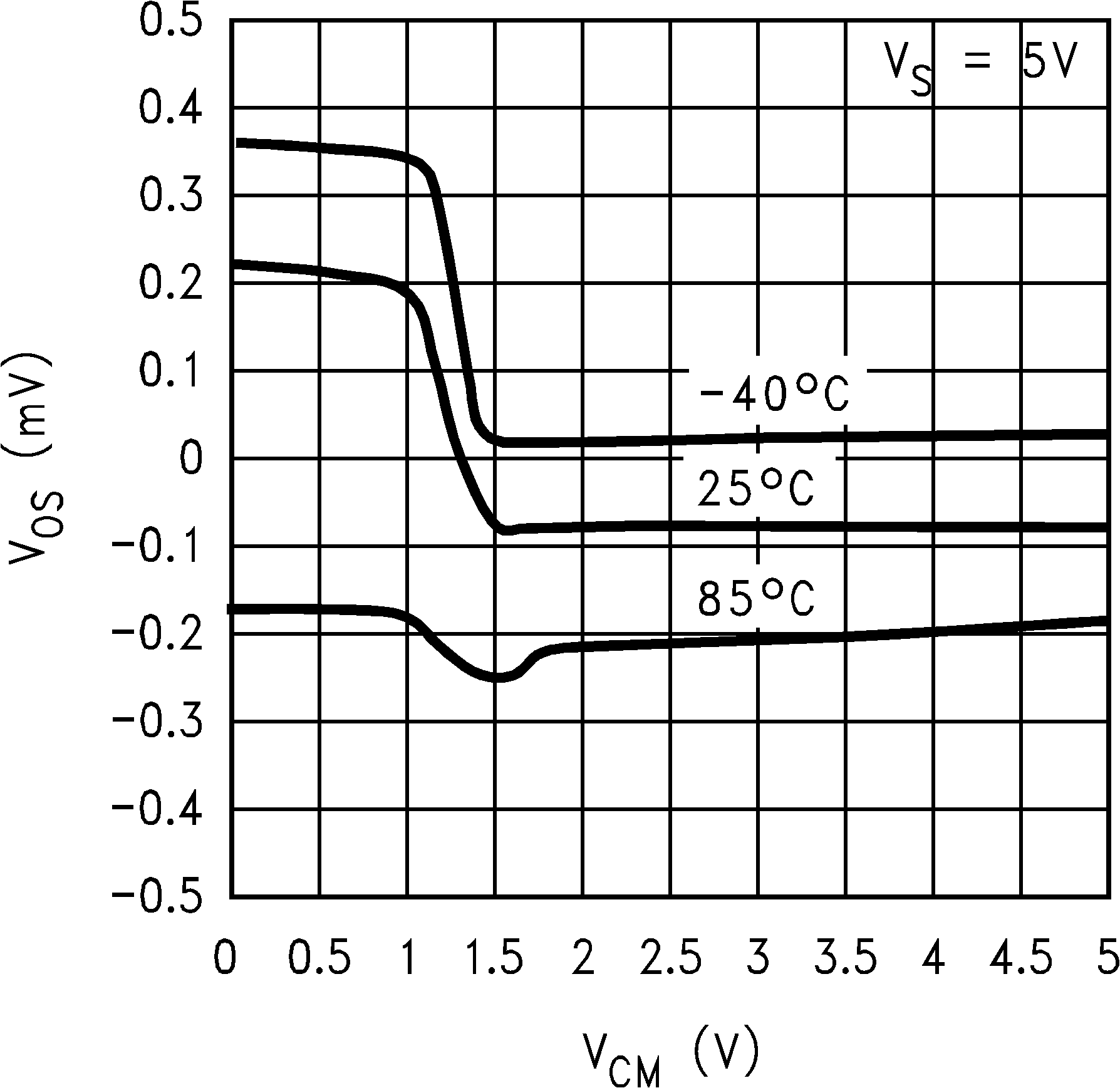SNOS519K April 2000 – August 2016 LMV710-N
PRODUCTION DATA.
- 1 Features
- 2 Applications
- 3 Description
- 4 Revision History
- 5 Pin Configuration and Functions
- 6 Specifications
- 7 Detailed Description
- 8 Application and Implementation
- 9 Power Supply Recommendations
- 10Layout
- 11Device and Documentation Support
- 12Mechanical, Packaging, and Orderable Information
Package Options
Mechanical Data (Package|Pins)
- DBV|5
Thermal pad, mechanical data (Package|Pins)
Orderable Information
6 Specifications
6.1 Absolute Maximum Ratings
over operating free-air temperature range (unless otherwise noted)(1)(2)| MIN | MAX | UNIT | ||
|---|---|---|---|---|
| Differential input voltage | ±Supply voltage | |||
| Voltage at input or output pin | (V–) − 0.4 | (V+) + 0.4 | V | |
| Supply voltage (V+ - V −) | 5.5 | V | ||
| Output short circuit to V+ | See(3) | |||
| Output short circuit to V− | See(4) | |||
| Current at input pin | ±10 | mA | ||
| Mounting temperature, infrared or convection (20 sec) | 235 | °C | ||
| Junction temperature, TJ(MAX)(5) | 150 | °C | ||
| Storage temperature, Tstg | –65 | 150 | °C | |
(1) Stresses beyond those listed under Absolute Maximum Ratings may cause permanent damage to the device. These are stress ratings only, which do not imply functional operation of the device at these or any other conditions beyond those indicated under Recommended Operating Conditions. Exposure to absolute-maximum-rated conditions for extended periods may affect device reliability.
(2) If Military/Aerospace specified devices are required, please contact the Texas Instruments Sales Office/ Distributors for availability and specifications.
(3) Shorting circuit output to V+ will adversely affect reliability.
(4) Shorting circuit output to V− will adversely affect reliability.
(5) The maximum power dissipation is a function of TJ(MAX), RθJA, and TA. The maximum allowable power dissipation at any ambient temperature is PD = (TJ(MAX) – T A) / RθJA. All numbers apply for packages soldered directly into a PCB.
6.2 ESD Ratings
| VALUE | UNIT | |||
|---|---|---|---|---|
| V(ESD) | Electrostatic discharge | Human-body model (HBM)(1)(2) | ±2000 | V |
| Machine model (MM)(3) | ±100 | |||
(1) JEDEC document JEP155 states that 500-V HBM allows safe manufacturing with a standard ESD control process.
(2) Human-body model, 1.5 kΩ in series with 100 pF.
(3) Machine model, 0 Ω in series with 100 pF.
6.3 Recommended Operating Conditions
over operating free-air temperature range (unless otherwise noted)| MIN | MAX | UNIT | |
|---|---|---|---|
| Supply voltage | 2.7 | 5 | V |
| Temperature | –40 | 85 | °C |
6.4 Thermal Information
| THERMAL METRIC(1) | LMV710-N | LMV711-N | LMV715-N | UNIT | |
|---|---|---|---|---|---|
| DBV (SOT-23) | DBV (SOT-23) | DBV (SOT-23) | |||
| 5 PINS | 6 PINS | 6 PINS | |||
| RθJA | Junction-to-ambient thermal resistance | 265 | 265 | 265 | °C/W |
| RθJC(top) | Junction-to-case (top) thermal resistance | 131.6 | 139 | 156.6 | °C/W |
| RθJB | Junction-to-board thermal resistance | 35.1 | 38.5 | 32.8 | °C/W |
| ψJT | Junction-to-top characterization parameter | 22.2 | 28.6 | 34 | °C/W |
| ψJB | Junction-to-board characterization parameter | 34.5 | 37.9 | 32.2 | °C/W |
| RθJC(bot) | Junction-to-case (bottom) thermal resistance | — | — | — | °C/W |
(1) For more information about traditional and new thermal metrics, see the Semiconductor and IC Package Thermal Metrics application report.
6.5 Electrical Characteristics – 2.7 V
TJ = 25°C, V+ = 2.7 V, V− = 0 V, VCM = 1.35 V, and RL > 1 MΩ (unless otherwise noted)| PARAMETER | TEST CONDITIONS | MIN(1) | TYP(2) | MAX(1) | UNIT | ||
|---|---|---|---|---|---|---|---|
| VOS | Input offset voltage | VCM = 0.85 V and VCM = 1.85 V |
TJ = 25°C | 0.4 | 3 | mV | |
| TJ = –40°C to 85°C | 3.2 | ||||||
| IB | Input bias current | 4 | pA | ||||
| CMRR | Common-mode rejection ratio |
0 V ≤ VCM ≤ 2.7 V | TJ = 25°C | 50 | 75 | dB | |
| TJ = –40°C to 85°C | 45 | ||||||
| PSRR | Power supply rejection ratio | 2.7 V ≤ V+ ≤ 5 V, VCM = 0.85 V |
TJ = 25°C | 70 | 110 | dB | |
| TJ = –40°C to 85°C | 68 | ||||||
| 2.7 V ≤ V+ ≤ 5 V, VCM = 1.85 V |
TJ = 25°C | 70 | 95 | ||||
| TJ = –40°C to 85°C | 68 | ||||||
| VCM | Input common-mode voltage range | For CMRR ≥ 50 dB | V– | –0.2 | –0.3 | V | |
| V+ | 3 | 2.9 | |||||
| ISC | Output short-circuit current | Sourcing, VO = 0 V | TJ = 25°C | 15 | 28 | mA | |
| TJ = –40°C to 85°C | 12 | ||||||
| Sinking, VO = 2.7 V | TJ = 25°C | 25 | 40 | ||||
| TJ = –40°C to 85°C | 22 | ||||||
| VO | Output swing | RL = 10 kΩ to 1.35 V VID = 100 mV |
TJ = 25°C | 2.62 | 2.68 | V | |
| TJ = –40°C to 85°C | 2.6 | ||||||
| RL = 10 kΩ to 1.35 V VID = –100 mV |
TJ = 25°C | 0.01 | 0.12 | ||||
| TJ = –40°C to 85°C | 0.15 | ||||||
| RL = 600 Ω to 1.35 V VID = 100 mV |
TJ = 25°C | 2.52 | 2.55 | ||||
| TJ = –40°C to 85°C | 2.5 | ||||||
| RL = 600 Ω to 1.35 V VID = –100 mV |
TJ = 25°C | 0.05 | 0.23 | ||||
| TJ = –40°C to 85°C | 0.3 | ||||||
| VO(SD) | Output voltage level in shutdown mode |
LMV711 only | 50 | 200 | mV | ||
| IO(SD) | Output leakage current in shutdown mode |
LMV715 only | 1 | pA | |||
| CO(SD) | Output capacitance in shutdown mode |
LMV715 only | 32 | pF | |||
| IS | Supply current | ON mode | TJ = 25°C | 1.22 | 1.7 | mA | |
| TJ = –40°C to 85°C | 1.9 | ||||||
| Shutdown mode, VSD = 0 V | 0.002 | 10 | µA | ||||
| AV | Large signal voltage | Sourcing, RL = 10 kΩ, VO = 1.35 V to 2.3 V |
TJ = 25°C | 80 | 115 | dB | |
| TJ = –40°C to 85°C | 76 | ||||||
| Sinking, RL = 10 kΩ, VO = 0.4 V to 1.35 V |
TJ = 25°C | 80 | 113 | ||||
| TJ = –40°C to 85°C | 76 | ||||||
| Sourcing, RL = 600 Ω, VO = 1.35 V to 2.2 V |
TJ = 25°C | 80 | 110 | ||||
| TJ = –40°C to 85°C | 76 | ||||||
| Sinking, RL = 600 Ω, VO = 0.5 V to 1.35 V |
TJ = 25°C | 80 | 100 | ||||
| TJ = –40°C to 85°C | 76 | ||||||
| SR | Slew rate(3) | 5 | V/µs | ||||
| GBWP | Gain-bandwidth product | 5 | MHz | ||||
| φm | Phase margin | 60 | ° | ||||
| TON | Turnon time from shutdown | <10 | µs | ||||
| VSD | Shutdown pin voltage range | ON mode | 2.4 | 1.5 | 2.7 | V | |
| Shutdown mode | 0 | 1 | 0.8 | ||||
| en | Input-referred voltage noise | f = 1 kHz | 20 | nV/√Hz | |||
(1) All limits are specified by testing or statistical analysis.
(2) Typical values represent the most likely parametric norm.
(3) Number specified is the slower of the positive and negative slew rates.
6.6 Electrical Characteristics – 3.2 V
TJ = 25°C, V+ = 3.2 V, V− = 0 V, and VCM = 1.6 V (unless otherwise noted)| PARAMETER | TEST CONDITIONS | MIN(1) | TYP(2) | MAX(1) | UNIT | ||
|---|---|---|---|---|---|---|---|
| VO | Output Swing | IO = 6.5 mA | TJ = 25°C | 2.95 | 3 | V | |
| TJ = –40°C to 85°C | 2.92 | ||||||
| TJ = 25°C | 0.01 | 0.18 | |||||
| TJ = –40°C to 85°C | 0.25 | ||||||
(1) All limits are specified by testing or statistical analysis.
(2) Typical values represent the most likely parametric norm.
6.7 Electrical Characteristics – 5 V
TJ = 25°C, V+ = 5 V, V− = 0 V, VCM = 2.5 V, and RL > 1 MΩ (unless otherwise noted)| PARAMETER | TEST CONDITIONS | MIN(1) | TYP(2) | MAX(1) | UNIT | ||
|---|---|---|---|---|---|---|---|
| VOS | Input offset voltage | VCM = 0.85 V and VCM = 1.85 V |
TJ = 25°C | 0.4 | 3 | mV | |
| TJ = –40°C to 85°C | 3.2 | ||||||
| IB | Input bias current | 4 | pA | ||||
| CMRR | Common-mode rejection ratio |
0 V ≤ VCM ≤ 5 V | TJ = 25°C | 50 | 70 | dB | |
| TJ = –40°C to 85°C | 48 | ||||||
| PSRR | Power supply rejection ratio | 2.7 V ≤ V+ ≤ 5 V, VCM = 0.85 V |
TJ = 25°C | 70 | 110 | dB | |
| TJ = –40°C to 85°C | 68 | ||||||
| 2.7 V ≤ V+ ≤ 5 V, VCM = 1.85 V |
TJ = 25°C | 70 | 95 | ||||
| TJ = –40°C to 85°C | 68 | ||||||
| VCM | Input common-mode voltage range |
For CMRR ≥ 50 dB | V– | –0.2 | –0.3 | V | |
| V+ | 5.3 | 5.2 | |||||
| ISC | Output short-circuit current | Sourcing, VO = 0 V | TJ = 25°C | 25 | 35 | mA | |
| TJ = –40°C to 85°C | 21 | ||||||
| Sinking, VO = 5 V | TJ = 25°C | 25 | 40 | ||||
| TJ = –40°C to 85°C | 21 | ||||||
| VO | Output swing | RL = 10 kΩ to 2.5 V VID = 100 mV |
TJ = 25°C | 4.92 | 4.98 | V | |
| TJ = –40°C to 85°C | 4.9 | ||||||
| RL = 10 kΩ to 2.5 V VID = –100 mV |
TJ = 25°C | 0.01 | 0.12 | ||||
| TJ = –40°C to 85°C | 0.15 | ||||||
| RL = 600 Ω to 2.5 V VID = 100 mV |
TJ = 25°C | 4.82 | 4.85 | ||||
| TJ = –40°C to 85°C | 4.8 | ||||||
| RL = 600 Ω to 2.5 V VID = –100 mV |
TJ = 25°C | 0.05 | 0.23 | ||||
| TJ = –40°C to 85°C | 0.3 | ||||||
| VO(SD) | Output voltage level in shutdown mode |
LMV711 only | 50 | 200 | mV | ||
| IO(SD) | Output leakage current in shutdown mode |
LMV715 only | 1 | pA | |||
| CO(SD) | Output capacitance in shutdown mode |
LMV715 only | 32 | pF | |||
| IS | Supply current | ON mode | TJ = 25°C | 1.17 | 1.7 | mA | |
| TJ = –40°C to 85°C | 1.9 | ||||||
| Shutdown mode | 0.2 | 10 | µA | ||||
| AV | Large signal voltage gain | Sourcing, RL = 10 kΩ, VO = 2.5 V to 4.6 V |
TJ = 25°C | 80 | 123 | dB | |
| TJ = –40°C to 85°C | 76 | ||||||
| Sinking, RL = 10 kΩ, VO = 0.4 V to 2.5 V |
TJ = 25°C | 80 | 120 | ||||
| TJ = –40°C to 85°C | 76 | ||||||
| Sourcing, RL = 600 Ω, VO = 2.5 V to 4.5 V |
TJ = 25°C | 80 | 110 | ||||
| TJ = –40°C to 85°C | 76 | ||||||
| Sinking, RL = 600 Ω, VO = 0.5 V to 2.5 V |
TJ = 25°C | 80 | 118 | ||||
| TJ = –40°C to 85°C | 76 | ||||||
| SR | Slew rate(3) | 5 | V/µs | ||||
| GBWP | Gain-bandwidth product | 5 | MHz | ||||
| φm | Phase margin | 60 | ° | ||||
| TON | Turnon time from shutdown | <10 | µs | ||||
| VSD | Shutdown pin voltage range | ON mode | 2.4 | 2 | 5 | V | |
| Shutdown mode | 0 | 1.5 | 0.8 | ||||
| en | Input-referred voltage noise | f = 1 kHz | 20 | nV/√Hz | |||
(1) All limits are specified by testing or statistical analysis.
(2) Typical values represent the most likely parametric norm.
(3) Number specified is the slower of the positive and negative slew rates.
6.8 Typical Characteristics
VS = 5 V, single supply, TA = 25°C (unless otherwise noted)
vs Supply Voltage (ON Mode)

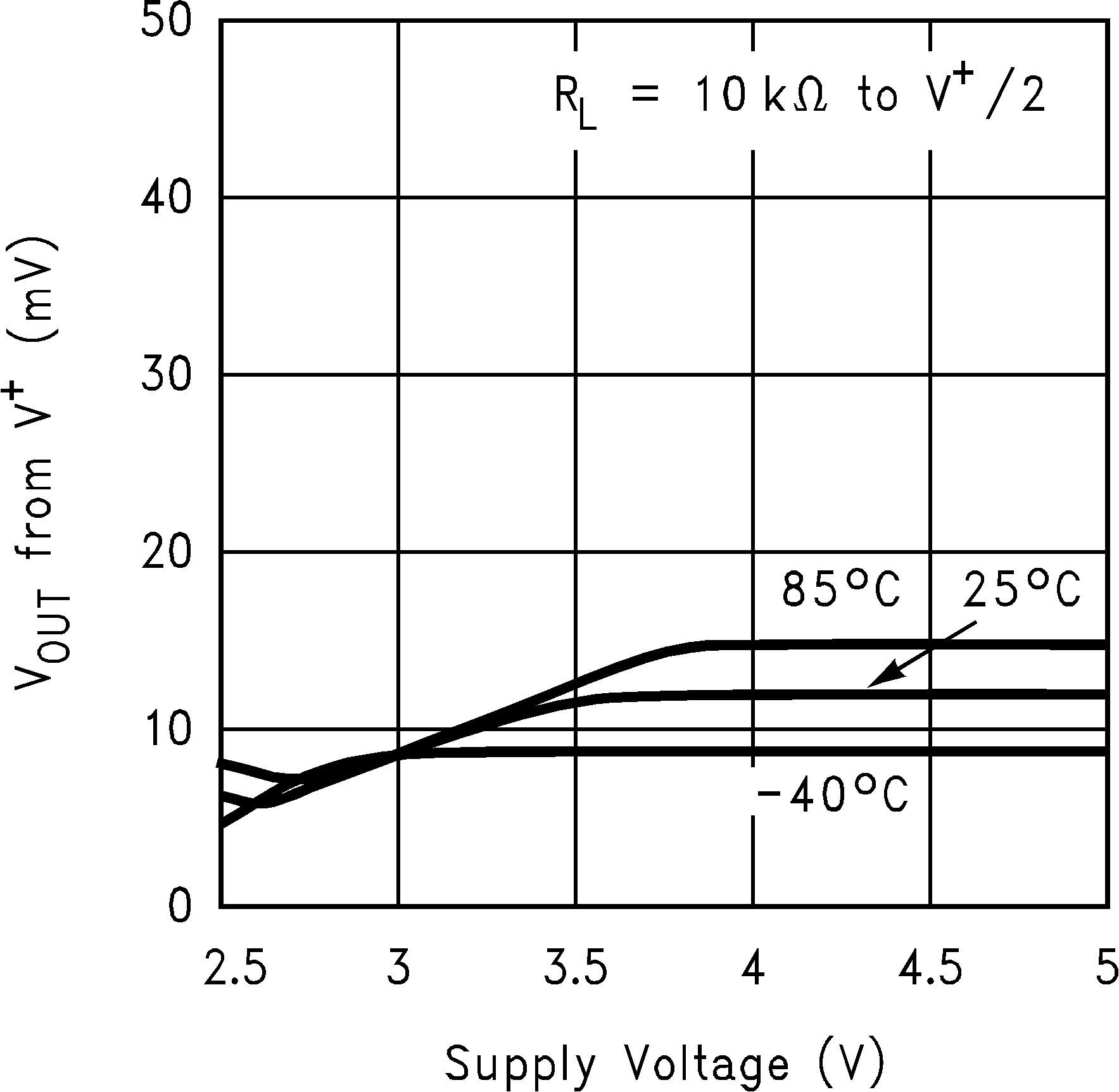
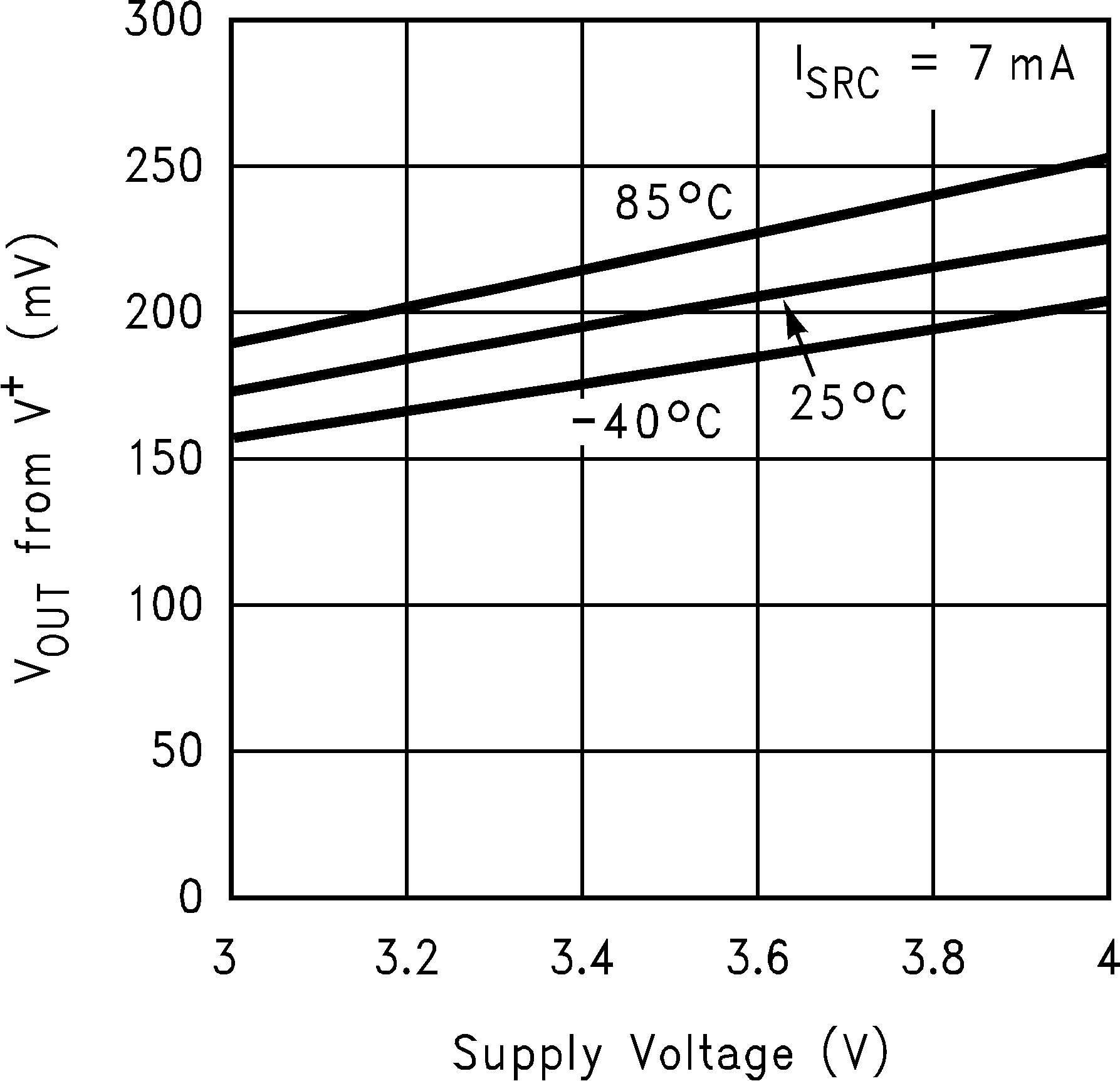










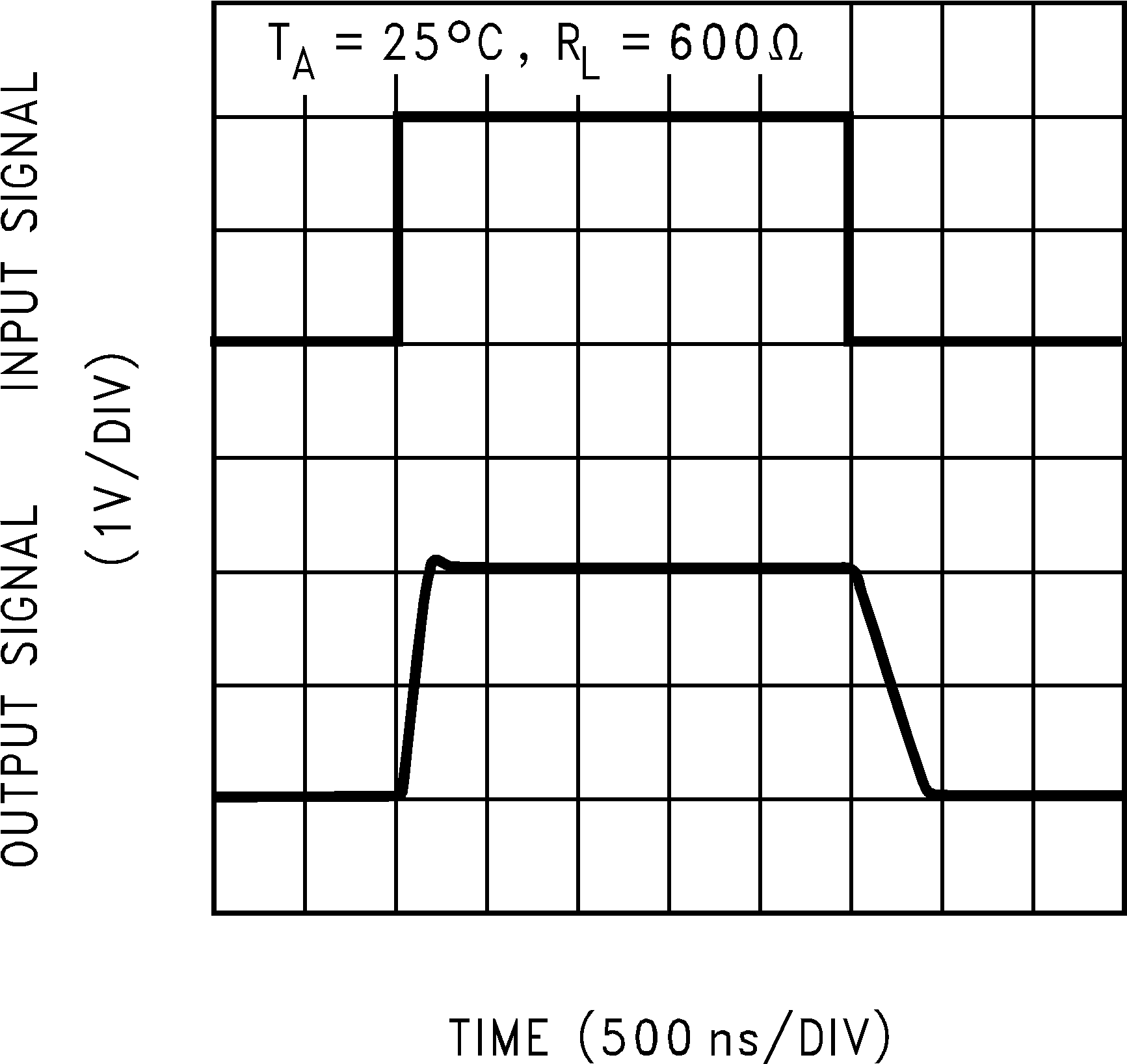
Signal Pulse Response



vs Supply Voltage (Shutdown Mode)












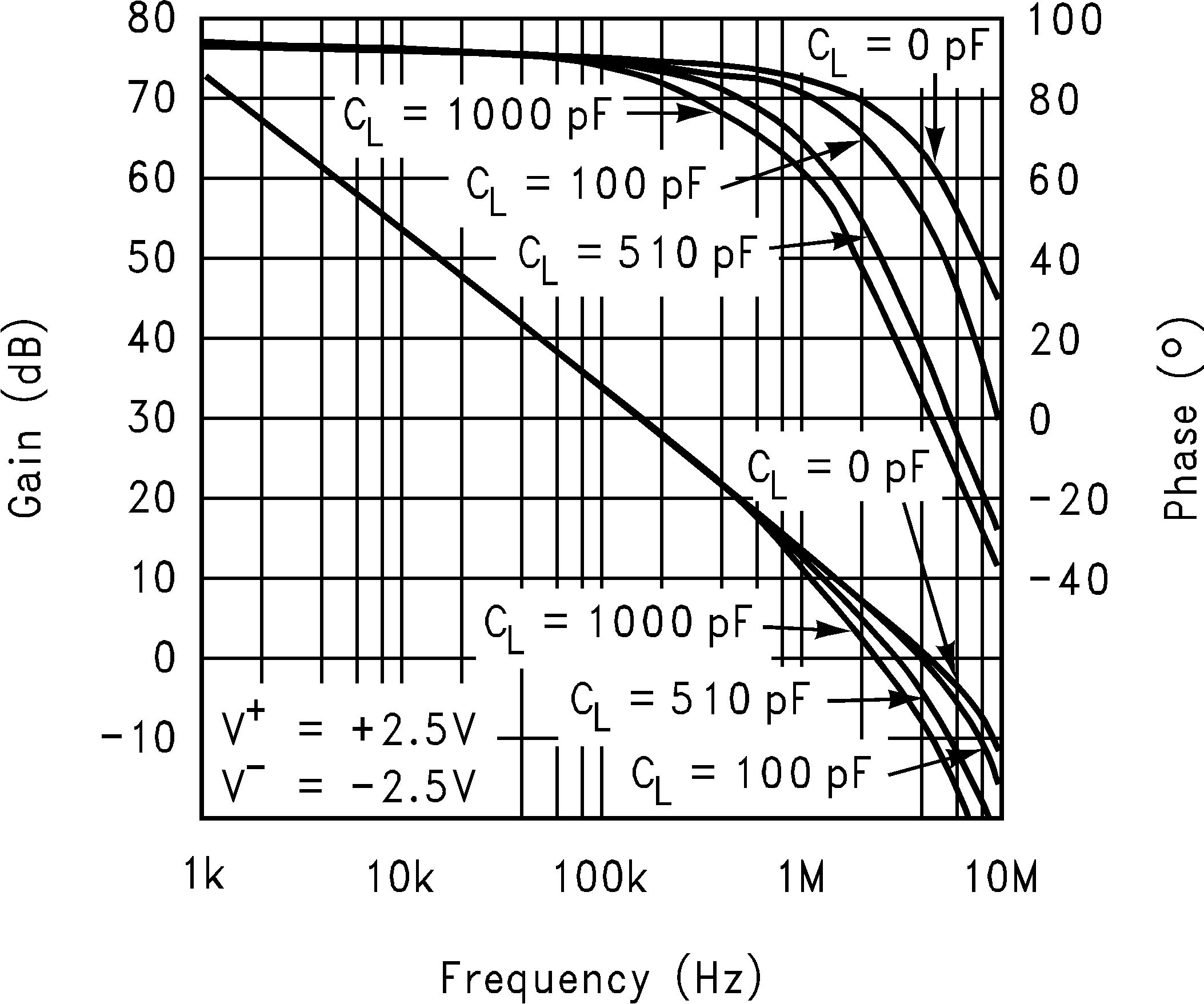
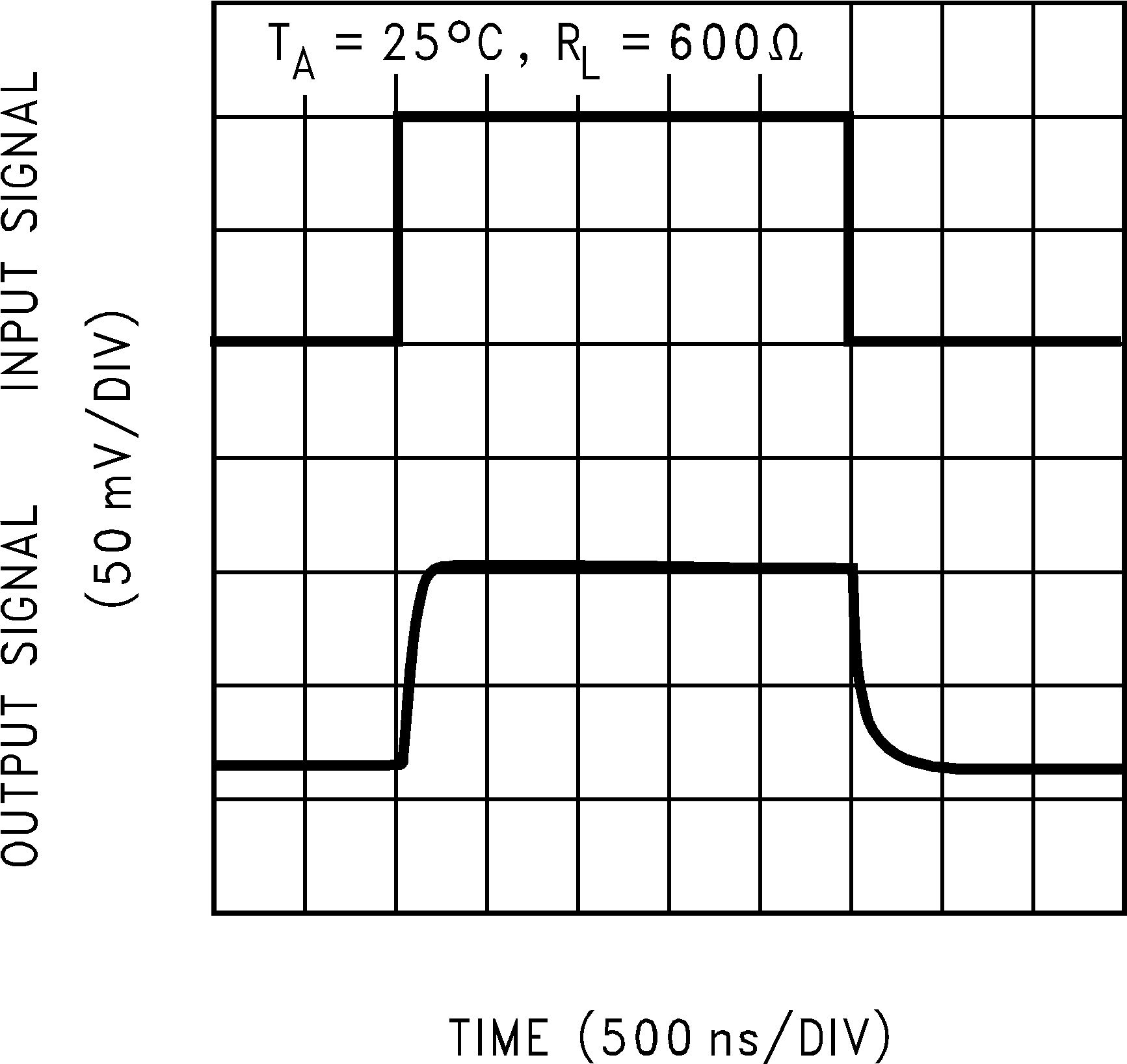
Signal Pulse Response

